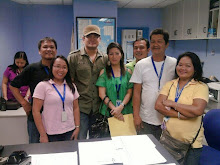Diwata-2 marks anniversary with demo of localized technologies and applications
PHL-Microsat
QUEZON CITY, PHILIPPINES — “Translating knowledge into local technologies and applications” was the chosen theme for the simple celebration marking the first anniversary of Diwata-2 in space, which was held at the University of the Philippines Diliman Electrical and Electronics Engineering Institute (UP-EEEI) on October 29, 2019.
Sharing the press release for your reference, as well as some more downloadable photos and reference materials here.
QUEZON CITY, PHILIPPINES — “Translating knowledge into local technologies and applications” was the chosen theme for the simple celebration marking the first anniversary of Diwata-2 in space, which was held at the University of the Philippines Diliman Electrical and Electronics Engineering Institute (UP-EEEI) on October 29, 2019.
A Year in Space. STAMINA4Space researcher Shielo Namuco summarizing the microsatellite’s status and operations during the morning program.
Diwata-2 is a 50-kilogram Earth observation microsatellite built by a team from the University of the Philippines Diliman (UPD) and the Advanced Science and Technology Institute of the Department of Science and Technology (DOST-ASTI), in cooperation with Tohoku University and Hokkaido University in Japan. It was successfully deployed into 600 km Sun-Synchronous Orbit on October 29, 2018. Development of the microsatellite began under the research program, “Development of the Philippines Scientific Earth Observation Microsatellite (PHL-Microsat)” and was completed under the “Space Technology & Applications Mastery, Innovation and Advancement (STAMINA4Space)” program, which continues to operate the microsatellite along with its predecessor, Diwata-1. Both programs are funded by the DOST Grants-in-Aid (DOST-GIA) and monitored by DOST’s Philippine Council for Industry, Energy and Emerging Technology Research and Development (PCIEERD). It is the Philippines’ third satellite sent to space, following the 50 kg. Microsatellite Diwata-1 (
As a “science satellite” built in an academic environment, Diwata-2 is primarily intended to conduct scientific measurements and experiments for environmental assessment and monitoring, which can be carried out by its on-board cameras. In its first year in space, Diwata-2 has acquired images covering 46.06% of the Philippines, which are being distributed in the website http://www.phl-
Key messages delivered by (clockwise from top) UP-EEEI Director Director Dr. Michael Pedrasa, current DOST Undersecretary for Research and Development Dr. Rowena Guevara (middle) and former Undersecretary Dr. Amelia Guevara (rightmost), DOST-PCIEERD Executive Director Dr. Enrico Paringit, and STAMINA4Space PHL-50 Project Leader Dr. Marc Talampas.
In her opening message, DOST Undersecretary for Research and Development Dr. Rowena Guevara said, “The event’s theme, ‘Translating knowledge to local technologies and applications’ captures what the team has been doing since then,” and later added, “We hope to continue this momentum by fostering more local and international linkages and choosing more skilled and passionate researchers in this field in paving the way for future satellites, not only future Diwatas but possibly even more sophisticated satellites that bear the names of more Philippine icons that can proudly symbolize how far the Filipino stamp of ingenuity and innovation can take us.”
The researchers’ presentations aimed to show just that, which STAMINA4Space PHL-50 Project Leader Dr. Marc Talampas afterwards summarized in numbers: 13, the number of satellites that are either in orbit, in the lab as engineering models, or under development nurtured by Filipino hands; 46.06%, the percentage of Philippine land area Diwata-2 has captured; 672, the number of screws that had to be checked after every vibration test during Diwata-2’s development (an example of meticulous engineering rigor needed); 3, the “trinity of vision” — light source, object, and detector (basic principles that Diwata-2’s optical payloads operate under); and 101 — for Philippines-Oscar 101 (PO-101), which was designated by AMSAT to Diwata-2’s ARU on April 11 this year.
Morning presentations from (left to right): STAMINA4Space Diwata-2 Project Manager and head of DOST-ASTI’s Solutions and Services Engineering Division Embedded Systems Group Engr. Gerwin Guba on developing Diwata-2, STAMINA4Space OPTIKAL Project Chief Science Research Specialist Dr. Atchong Hilario on payload development and local partners, and STAMINA4Space STeP-UP Embedded Systems Engineer Mary Ann Constante on the Amateur Radio Satellite Station and satellite communications.
Guided tours of the University Laboratory for Small Satellite and Space Engineering Systems (ULyS3ES) facility were also opened to the public in the afternoon to interactively showcase the technologies on-board the microsatellite, as well as the localization efforts being made by the STAMINA4Space Program’s different project teams. Over 40 people were accommodated, including grade school to college students, faculty members from some Metro Manila schools, and general STEM enthusiasts.
STAMINA4Space Optical Payload Technology, In-Depth Knowledge Acquisition and Localization (OPTIKAL) Project Leader Dr. Maricor Soriano weighed in on what she believes is the most important output of the continuous development of satellites like Diwata-2.
Some of the demo stations showing (from left to right) the OPTIKAL team’s payload development, the PHL-50 team’s gamified Star Tracker demo, STeP-UP scholars showing how Maya-1 works, GRASPED researchers discussing Diwata data applications, and the PEDRO ground receiving station operations streaming live from DOST-ASTI.
“More than having our own satellite, I would like to emphasize that what’s more important… ay hindi iyung satellite — it’s the people. Kasi po pag marunong gumawa ng kahit ano itong ating team, kahit ano pa iyung ipagawa mo sa kanila, kaya nila. It’s really the investing in the people na ang pinakaimportante na output nitong program na ito,” she said.
STAMINA4Space Program Leader and DOST-ASTI Acting Director Dr. Joel Marciano, Jr. also highlighted the importance of space technology research in developing people, data and industry, representing three innovation thrusts of the STAMINA4Space program.
“If we don’t start and sustain this, we will forever be consumers of technology and data provided by other countries,” he said, and offered perspectives on how space technology can feed into the local innovation ecosystem. “We aim to derive economic benefits from space — getting data, building electronics and instruments that can feed into industry through differentiated products and services, training people like the young people that you see here — so that we are not continuously left behind. The future lies in getting data and information from wherever we can get it (and) that includes the strategic vantage point of space.”
For more information, visit phl-microsat.upd.edu.ph/
For your information and dissemination please.
Thank you.
Ma. Lilibeth P. Padilla
Public Affairs Unit, Communication Resources and Production Division
Science and Technology Information Institute
Department of Science and Technology (DOST-STII)
Telephone no: 837-2192 / 837-2071 (loc 2142)
Mobile no: 0961-361-8357 / 0927-434-2277
Get Connected: https://www.










Mga Komento